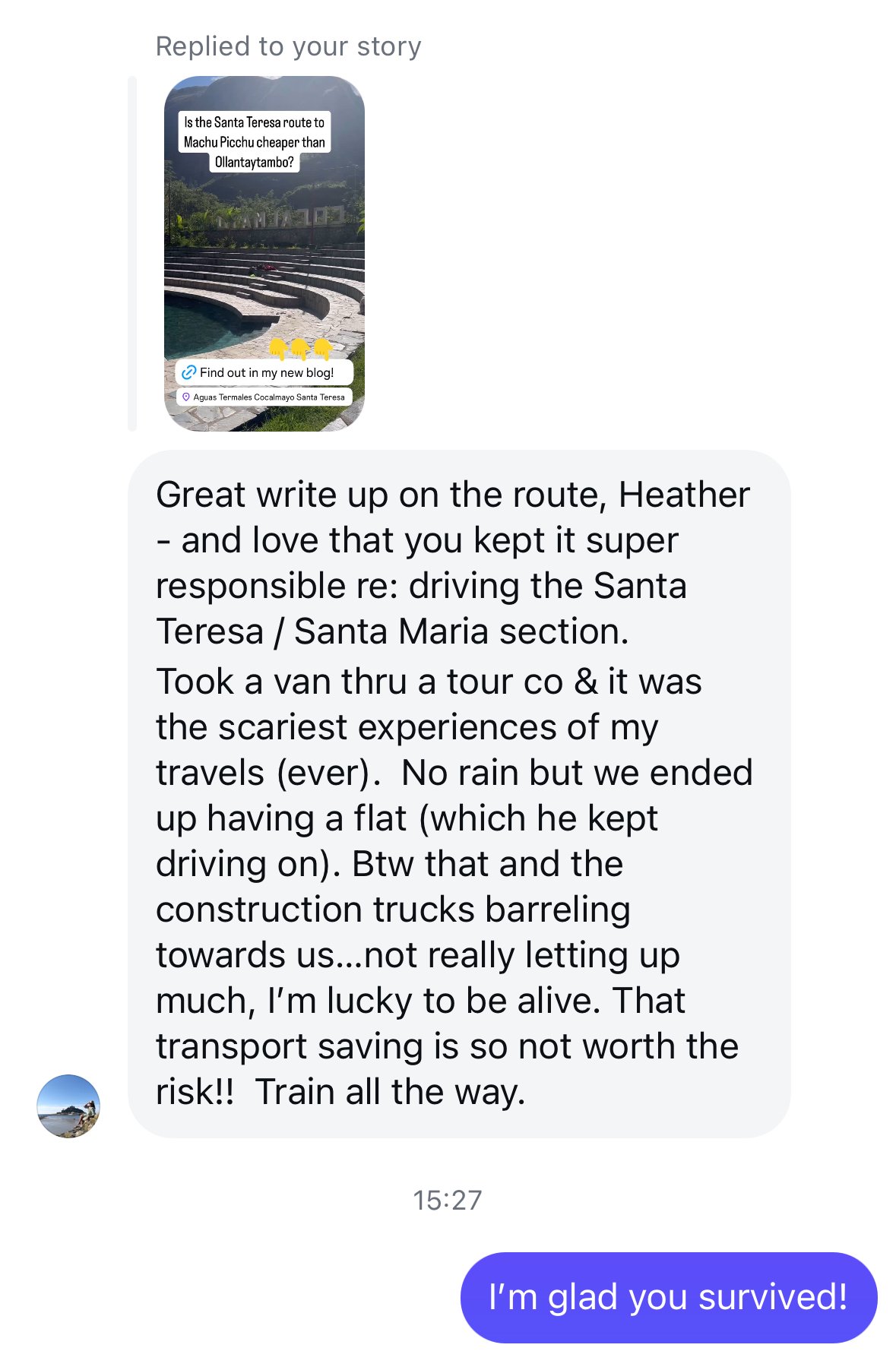Backpackers’ Route to Machu Picchu
Santa Teresa is a beautiful spot below the cloud forest, with a river in the middle of town.
The Santa Teresa Route to Machu Picchu
Here’s everything you need to know about Santa Teresa: what to do, where to stay, where to eat and how to get there! Plus, the cost & time details for the Santa Teresa vs. Ollantaytambo routes to Machu Picchu.
What to do in Santa Teresa?
The Cocalmayo hot springs are some of my favorites in all of Peru.
Soak in the hot springs.
You absolutely must go to the Cocalmayo hot springs! There are several pools, each with a different temperature. The main pool is against a cliff so one side of the pool is natural rock, which has several shelfs that are perfect for sitting from up to your waist to up to your neck in the water. Also, as the sun gets hotter and more intense around 11am, the trees above naturally shade this side of the pool. That alone makes Cocalmayo one of the best hot springs anywhere in Peru. Unlike many other hot springs in the area, like Aguas Calientes and Lares, the water at Cocalmayo has a low mineral content, so the water is clear to turquoise. (The water is very cloudy in both Aguas Calientes & Lares).
From Santa Teresa, Cocalmayo is a short drive (5 min), or a half hour walk along the river. There are several washouts along the way, so you’ll be walking on a dirt road. It’s open 5am to 6pm or 7pm, depending on how many people are still there at 6pm. Entrance is s/10 soles, with discounts for locals. Bring your own swimsuit, towel, water, snacks and optional padlock. There are free lockers, but you need your own lock, available for a few soles at any hardware store in Santa Teresa.
Just outside the hot springs entrance is several restaurants and shops where you can buy or rent swimsuits and towels. They also have floaty toys, swim goggles and things for kids. Alcohol is not allowed in the hot springs, so if you like a beer or cocktail after a soak, you’ll need to go outside to one of these restaurants.
Zipline across the canyon.
There are a few zipline companies near Santa Teresa but the only one I recommend is Vertikal because they have the highest safety standards and the most experienced and best trained staff. They also have the longest zipline in Peru, with 3km (1.86mi) on four separate ziplines and a hanging bridge.
Where to stay in Santa Teresa?
Santa Teresa has two nice lodges, several budget hostels and the lodge at Cocalmayo. The two lodges I recommend are Eco Quechua and Vertikal.
Eco Quechua Lodge is best if you want to be able to walk into Santa Teresa easily and feel independent. It has several beautiful areas to hang out, with great views, plus a sauna and two small pools. The sauna is a small dome with a hobbit door that they line with fresh eucalyptus leaves gathered from the trees that surround the lodge.
Vertikal Lodge is best if you want to be up on a ridge, farther from town, and if you like privacy. The rooms are larger than Eco Quechua and there are only five total, so the place never feels crowded. However, it’s a bit of a walk to get down to town and you may have to ask the staff to drive you down to Santa Teresa.
There is also a lodge above the Cocalmayo hot springs, which I didn’t visit. It’s even farther from town than Vertikal, so only stay there if you intend to spend all your time at the lodge and hot springs.
Of the budget hostels, my favorite is Hospedaje Quillabamba, opened by Mario in 2005. Prices are around s/100 soles, depending on the room and number of people. Call Mario or write to him on Whatsapp +51 962 294 080 He also has a mototaxi (tuktuk) and can take you to Cocalmayo or the hydroelectric train station.
Where to eat in Santa Teresa?
Your hostel or hotel will include breakfast, but if you want breakfast on your own, go to the upstairs of the market. Several stands make fresh fruit juices, breakfast sandwiches and sell coffee. For lunch and dinner, I have to confess that I went to the same place twice for lunch and twice for dinner: Valle Santa. It’s the only restaurant my friends in the area would recommend and the food quality rivals some of Cusco’s best restaurants. All photos above are Valle Santa.
Drink lots of coffee in Santa Teresa!
Some of the best coffee in Peru is grown around Santa Teresa, so I highly recommend indulging while you’re there and also buying some coffee beans to take home.
How to get to Santa Teresa?
There are three main ways to get to Santa Teresa: walk there on the Salkantay trek, take the train from Aguas Calientes & Machu Picchu, or take a van or bus from Cusco.
The Salkantay Trek
If you’re doing the Salkantay trek, you may have the option to stay an extra day in Santa Teresa. If there’s time in your schedule, I highly recommend a rest day in Santa Teresa, for all the reasons above.
The Aguas Calientes Train
The best way to get to Santa Teresa is on the train from Aguas Calientes, the closest town to Machu Picchu. The train costs $40 USD and you can buy your tickets at the station where you board the train. There are two trains daily from the hydroelectric train station to Aguas Calientes: the 7:50 departure arrives at 8:35 and the 4:35 departure arrives at 5:05. Trains from Aguas Calientes to the hydroelectric train station leave at 6:35am, arriving at 7:50am and 12:35pm arriving at 1:05pm.
If you don’t have a ticket you can buy it at the train station but get there 40 minutes early because there is only one window to buy tickets and June-August the line can be long. The ticket office is open 6:45-11:30am and 12:30-5pm and stops selling tickets 5 minutes before the train departs. The person who checks tickets on the train can sometimes sell tickets if you weren’t able to buy one ahead of time, but don’t count on it.
Travelers are welcome to use the commuter train but you must buy tickets in person and ahead of time.
Side Note: Why is there a train station called “Hidroeléctrica?”
The hydropower dam between Santa Teresa and Aguas Calientes generates all the electricity for Cusco and the surrounding area. People who work at the dam usually live in Santa Teresa, Aguas Calientes, Ollantaytambo or even as far away as Cusco. They use the train to commute to work at the dam. Since the Salkantay trek became popular, the train company has allowed foreign travelers to take the same train. They charge international visitors more than people who use the train to commute to work but you also get a newer, nicer carriage.
If you’ve already seen Machu Picchu, or simply don’t want to stop in Aguas Calientes, you can take the train from the power station to Ollantaytambo. There is a stop in Aguas Calientes and they might make you switch carriages, but you can usually stay on the same train until you get to Ollantaytambo.
Can you drive to Santa Teresa?
Yes, but – and this is a big but – the road is terrible. There have been several major landslides on the last section of the road between Santa María and Santa Teresa. Some areas continue to slide every time it rains, making the road very dangerous. If you are in Cusco during the rainy season December through April, I highly recommend paying for the train ticket from Ollantaytambo to Aguas Calientes. It is not worth the risk, or your time, to drive from Cusco to Santa Teresa, where you still have to pay $40 for the train to Aguas Calientes.
If you’re here when it’s not raining, the road is relatively stable, though still under construction and closed most of the time for construction. It opens for an hour or so three times a day (see photo above) to let cars through. There is no construction on Sunday so you don’t have to worry about the time of day.
What are the driving options from Cusco to Santa Teresa?
Every tour agency around the center of Cusco sells seats in vans that drive from Cusco directly to the hydroelectric train station. The price is around s/90 soles round trip, give or take 10 depending on demand and vehicle quality. They will drive you directly to the train station or you can get out in Santa Teresa, and they pick up at the train station. This is the easiest way to get back and forth.
Another option is the bus from Cusco to Quillabamba which costs s/35 soles. Go to Almudena street in Cusco for colectivo cars and vans. You can also buy a ticket with Inversiones K’intu for a comfortable bus with assigned seats. You’ll have to get off in Santa María and get a colectivo from there, which costs s/15 soles. From Santa Teresa to the train station is another s/10 soles or so, so this only makes sense if you want to stay in Santa Teresa. Otherwise, it’s faster and less expensive to pay for the van that goes directly from Cusco’s center to the hydroelectric train station. These vans are also a great way to meet other travelers, since they’re marketed almost exclusively to foreign tourists.
It takes about four and a half hours to drive from Cusco to Santa María and busses and vans usually make a pit stop somewhere along the way, which adds 15 or 20 minutes. The drive from Santa María down to Santa Teresa can take anywhere from one to two hours depending on how often you get stopped for construction. It’s another half hour from Santa Teresa to the hydroelectric train station.
The cost & time breakdown
A colectivo from Cusco to Ollantaytambo is s/10 soles and takes about an hour and a half. The cheapest train tickets from Ollantaytambo to Aguas Calientes are $60 USD and the train takes about 2 hours, plus another 45 minutes from Aguas to Hidroeléctrica. That’s about $63 & 5 hours each way: $126 total and about 10 hours round trip.
The van round trip Cusco to Hidroeléctrica is s/90 soles and the train from Hidroeléctrica to Aguas Calientes is $80 USD round trip. That’s $105 total. It takes 7-8 hours each way.
Note: It is possible to walk the train tracks from Hidroeléctrica to Aguas Calientes, which takes about 2 hours. However, this is technically illegal and signs along the tracks warn people from trying this. I do not recommend walking on train tracks.
Another transportation option is cars but my caution about not traveling when it’s raining applies.
The bottom line:
The Santa Teresa route is only worth it if you want to spend time in Santa Teresa to enjoy the hot springs, ziplines and to see small-town Peru. If you’re doing the Salkantay trek, spend a couple days in Santa Teresa, before going to Machu Picchu and then take the train back to Ollantaytambo and a colectivo to Cusco. The best way to get to Santa Teresa is the train from Aguas Calientes to Hidroeléctrica.
Do not take a van or car on the road from Santa María to Santa Teresa if it’s raining. The cost savings between the Santa Teresa route and the Ollantaytambo route is only $20 USD. The Santa Teresa route is about 16 hours round trip and the Ollantaytambo route is about 10 hours round trip.
Honest Feedback on Instagram
I post a lot of information on IG (follow me @heatherjaspertravels) and get a lot of responses from people planning to come to Peru and travelers who have already been here. I’m not the only person who thinks that road between Santa Maria and Santa Teresa isn’t worth the trouble!











































